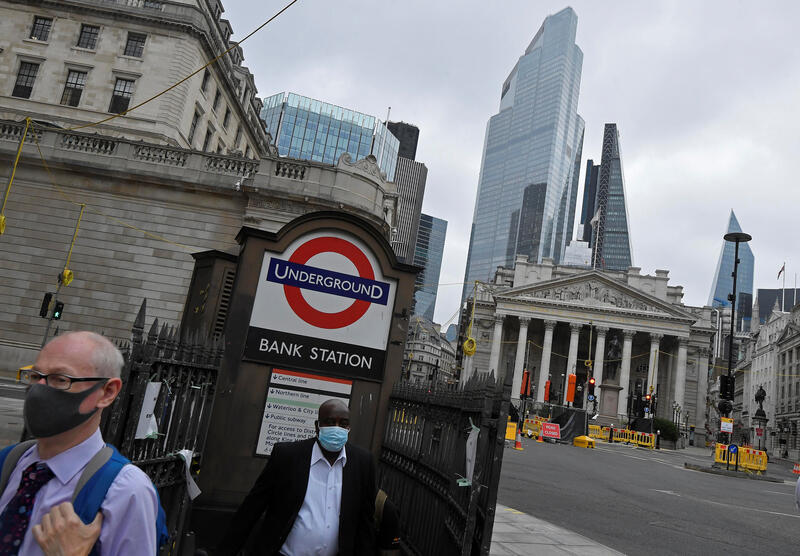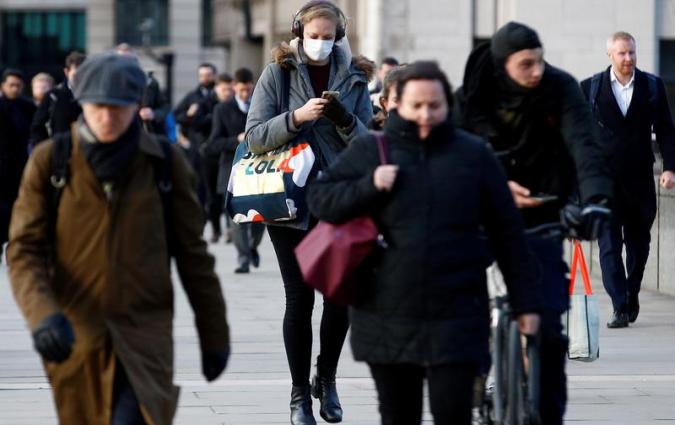In this piece
Consistent and widespread belief in the threat of COVID-19 to the UK economy

Workers wearing protective face masks walk near the Bank of England in the City of London, Britain, August 6, 2020. REUTERS/Toby Melville
In this piece
Key findings | Overview | Findings | | References | Footnotes | About the authors | Funding acknowledgementsThis is the ninth factsheet of the UK COVID-19 news and information project.
DOI: 10.60625/risj-154k-pp18
Key findings
In this RISJ Factsheet we explore how people perceive the threat of COVID-19 to their health, their finances, the economy, and the health of the population, based on a survey fielded from 30 July to 5 August.
We find that:
- Most people still see COVID-19 as quite threatening or very threatening to the UK economy (94%), the health of the UK population as a whole (80%), and their personal health (54%). 41% say COVID-19 is a threat to their personal finances.
- Belief in the threat of COVID-19 to the UK economy has been most widespread and most consistent, with the proportion believing COVID-19 to be quite or very threatening to the UK economy not dropping below 90% since mid-April.
- However, the proportion that say COVID-19 is threatening to the health of the UK population, their personal health, and to their personal finances has fallen by around 10 percentage points since mid-April.
- There are differences in the perceived threat of COVID-19 to individuals (their personal health and finances, as opposed to the health of the population and the economy) by demographic variables. Just 39% of those aged 18-34 see COVID-19 as quite threatening or very threatening to their personal health, compared to around two-thirds (63%) of those aged 55 and over. Similarly, those aged 55 and over are least likely to feel that COVID-19 threatens their personal finances.
- Those that consume COVID-19 news more frequently are slightly more likely to perceive COVID-19 as a threat to the UK economy, the health of the UK population, and their own personal health. However, the differences are quite small.
- More generally, just 17% think that the coronavirus situation in the UK is ‘heading in the right direction’ – the lowest figure we have seen since the start of the study in mid-April. 28% think that the situation is ‘on the wrong track’, and 48% think that the picture is mixed
Overview
This is the ninth in a series of ten factsheets based on an ongoing online panel survey of a representative sample of the UK population. The survey was designed by the Reuters Institute for the Study of Journalism at the University of Oxford to collect data on how people navigate news and information during the coronavirus pandemic and was fielded by YouGov. Ten waves will be fielded at two-week intervals, top-line findings from each will be published soon after in a factsheet, with more in-depth analysis to follow. More details about the project and the methodology can be found on the project website. The survey is a mix of tracking questions and specific questions fielded only in some waves.
Findings
Most people still see COVID-19 as a threat to their personal health (54%) and the health of the UK population as a whole (80%). Furthermore, 94% believe COVID-19 to be quite or very threatening to the UK economy, with 41% saying the same about the threat to their personal finances. The data was collected just before the Bank of England announced that the economic consequences of COVID-19 were likely to be less severe than initially expected, but the recovery might take longer.1
We asked respondents ‘How threatening, if at all, is the coronavirus pandemic to each of the following?’, with the numbers presented here indicating the proportion that selected ‘quite threatening’ or ‘very threatening’ (the other available options were ‘not at all threatening’, ‘not very threatening’, and ‘don’t know’). As such, we measure the perceived threat of COVID-19 to various dimensions of life in the UK, and not the actual threat, which may differ from people’s perceptions.
Since mid-April, fewer people perceive COVID-19 to be threatening to their personal health, their finances, and the health of the UK population as a whole. For all three of these, the proportion that say COVID-19 is quite or very threatening to each has fallen by around 10 percentage points since mid-April (see Figure 1).
Figure 1. Proportion that think COVID-19 is quite/very threatening to ____
COVID_Threat. How threatening, if at all, is the coronavirus pandemic to each of the following? Base: 10-14 Apr. = 2,823, 24-28 Apr. = 2,291, 7-13 May = 1,973, 21-27 May = 1,774, 4-10 June = 1,645, 18-24 June = 1,467, 2-8 July = 1,338, 16-22 July = 1,218, 30 July-5 Aug. = 1,117.
However, fears about the impact of COVID-19 on the UK economy have been most widespread and most consistent, with the proportion believing COVID-19 to be quite or very threatening to the UK economy not dropping below 90% since mid-April.
This does not necessarily mean that people think the economy is more important than people’s health. But it does align with our other data showing that, over the same time period, fewer people see COVID-19 as the single most important issue facing the UK, with a growing number of people instead identifying the economy as more pressing – though COVID-19 is still ahead (Fletcher et al. 2020). However, concerns about COVID-19 and the economy are intertwined, and this particular trend may reverse if there is a second wave of infections.
The macro-level threat posed by COVID-19 (e.g. to the UK economy and to the health of the population) and the micro-level threat to the health and finances of individuals (dashed lines in Figure 1) are also clearly intertwined, but our data suggests that the belief in the threat to the nation is more widespread than the threat to one’s own wellbeing.
One obvious reason for this is that the perceived threat to an individual’s wellbeing will depend on their circumstances. The reality of the situation is that COVID-19 presents a greater risk for some people than others. For example, the risk people face from COVID-19 increases as they get older.2 So it’s not surprising that (according to data collected between 30 July and 5 August) just 39% of those aged 18-34 see COVID-19 as quite threatening or very threatening to their personal health, compared to around two-thirds (63%) of those aged 55 and over (Figure 2). Similarly, those aged 55 and over are least likely to feel that COVID-19 threatens their personal finances, perhaps in part because their finances are likely to be more secure.
Figure 2. Proportion that think COVID-19 is quite/very threatening to ____ by age group
COVID_Threat. How threatening, if at all, is the coronavirus pandemic to each of the following? Base: 18-34 = 193, 35-54 = 311, 55+ = 693.
In terms of other demographic variables, women are slightly more likely to see COVID-19 as a threat to the health of the UK population and their own finances – as are those who self-identify with the political left. However, for both men and women, and those across the political spectrum, over 90% see COVID-19 as quite threatening or very threatening to the UK economy.
Alongside many other factors, news consumption may shape people’s perceptions of the threat posed by COVID-19, given that we know, for example, that news use is associated with people’s knowledge and beliefs about news and current affairs (Aalberg and Curran 2012; Garrett et al. 2016). It is very difficult to say what the appropriate levels of threat perception are during a situation like the COVID-19 crisis, and we do not attempt to do so here. Instead, we simply observe that people who more frequently consume COVID-19 news are also those slightly more likely to perceive COVID-19 as a threat to the UK economy, the health of the UK population, and their own personal health (Figure 3).3 There is no difference in the proportion of people that say COVID-19 is either quite threatening or very threatening to their personal finances by how frequently they consume COVID-19 news – perhaps because people’s perception of personal financial risk is less dependent on what is happening in the rest of the country.
Figure 3. Proportion that think COVID-19 is quite/very threatening to ____ by frequency of COVID-19 news use
COVID_Threat. How threatening, if at all, is the coronavirus pandemic to each of the following? Q4a. On how many of the last 7 days have you used each of the following as a source of news and information news or information about coronavirus (COVID-19)? Base: COVID-19 news once a day or more on average = 688, COVID-19 news less than once a day = 400.
It is important to point out, firstly, that the differences between the two groups are small, with the majority of relatively low COVID-19 news users (defined in Figure 3 as consuming COVID-19 news less frequently than once a day) seeing COVID-19 as a threat to the economy (91%) and the health of the population (73%). And more important still, that this data does not necessarily mean that COVID-19 news use is actually responsible for any differences in threat perceptions. As is clear from other research, other factors such as trust, prosociality and actual experience of coronavirus (Dryhurst et al. 2020), are likely to matter too – and some of these can be difficult to disentangle from news use. It also remains possible that people who perceive COVID-19 as more threatening are consuming more news in response.
Finally, our survey was in the field from 30 July to 5 August, a period in which deaths from COVID-19 in the UK grew from 45,961 to 46,299 (Roser et al. 2020), and much news coverage focused on the possibility of a second wave of infections across Europe. In a clear change from two weeks ago, when roughly equal numbers of people said that the coronavirus situation in the UK is ‘heading in the right direction’ and off ‘on the wrong track’, just 17% now think that the coronavirus situation in the UK is ‘heading in the right direction’ – the lowest figure we have seen since the start of the study in mid-April (Figure 4). 28% think that the situation is ‘on the wrong track’, and 48% think that the picture is mixed.
Figure 4. Proportion that think the coronavirus situation in the UK is generally heading in the right direction
Q19. All in all, do you think the Coronavirus situation in the UK is generally headed in the right direction, or do you feel things are off on the wrong track? Base: Total sample: 1,117.
References
- Aalberg, T., Curran, J. eds. 2012. How Media Inform Democracy: A Comparative Approach. New York: Routledge.
- Dryhurst, S., Schneider, C. R., Kerr, J., Freeman, A. L. J., Recchia, G., van der Bles, A. M., Spiegelhalter, D., van der Linden, S. 2020. ‘Risk Perceptions of COVID-19 Around the World.’, Journal of Risk Research 0(0): 1-13.
- Fletcher, R., Kalogeropoulos, A., Nielsen, R. K. 2020. News Avoidance in the UK Remains High as Lockdown Restrictions Are Eased. Oxford: Reuters Institute for the Study of Journalism.
- Garrett, R. K., Weeks, B. E., Neo, R. L. 2016. ‘Driving a Wedge Between Evidence and Beliefs: How Online Ideological News Exposure Promotes Political Misperceptions.’ Journal of Computer-Mediated Communication 21(5): 331-348.
- Roser, M., Ritchie, H., Ortiz-Ospina, E., Hasell, J. 2020. ‘Coronavirus Disease (COVID-19)’. Our World in Data. https://ourworldindata.org/coronavirus.
Footnotes
1 https://www.bbc.co.uk/news/business-53675467
2 https://www.nhs.uk/conditions/coronavirus-covid-19/people-at-higher-risk/whos-at-higher-risk-from-coronavirus/
3 We asked people ‘On how many of the last 7 days have you used each of the following as a source of news and information about coronavirus (COVID-19)?’ Respondents could select a number between 0 to 7 days for nine different sources, including TV, radio, and news websites. These were summed to create a variable ranging from 0 to 63. For the purposes of summarising the data in Figure 3, those less than 7 were placed in the ‘COVID-19 news less than once a day’ category, and those with 7 or more placed in the ‘COVID-19 news once a day or more on average’ category.
About the authors
Richard Fletcher is a Senior Research Fellow at the Reuters Institute for the Study of Journalism and leads the Institute’s research team.
Antonis Kalogeropoulos is a Lecturer in Communication and Media at the University of Liverpool and a Research Associate of the Reuters Institute for the Study of Journalism.
Rasmus Kleis Nielsen is the Director of the Reuters Institute for the Study of Journalism and Professor of Political Communication at the University of Oxford.
Funding acknowledgements
Factsheet published by the Reuters Institute for the Study of Journalism as part of the UK COVID-19 News and Information project funded by the Nuffield Foundation. The Nuffield Foundation is an independent charitable trust with a mission to advance social well-being. It funds research that informs social policy, primarily in Education, Welfare, and Justice. It also funds student programmes that provide opportunities for young people to develop skills in quantitative and scientific methods. The Nuffield Foundation is the founder and co-funder of the Nuffield Council on Bioethics and the Ada Lovelace Institute. The Foundation has funded this project, but the views expressed are those of the authors and not necessarily the Foundation. Visit www.nuffieldfoundation.org.
- Read about the project
- Read the project's first factsheet
- Read the project's second factsheet
- Read the project's third factsheet
- Read the project's fourth factsheet
- Read the project's fifth factsheet
- Read the project's sixth factsheet
- Read the project's seventh factsheet
- Read the project's first report
- Read the project's eighth factsheet

Published by the Reuters Institute for the Study of Journalism.

This report can be reproduced under the Creative Commons licence CC BY. For more information please go to this link.




